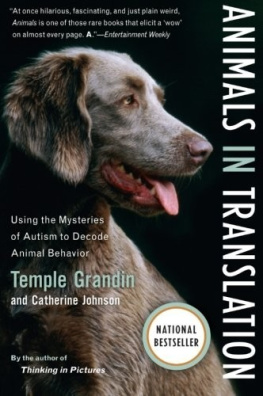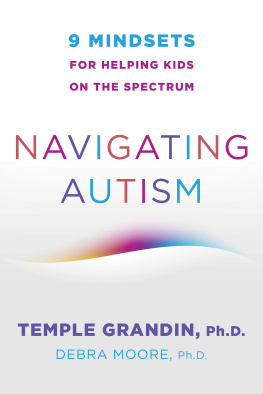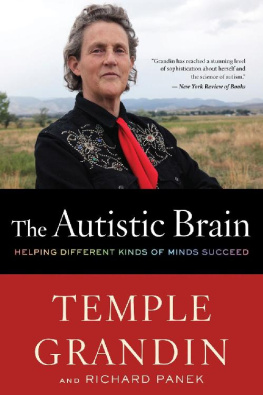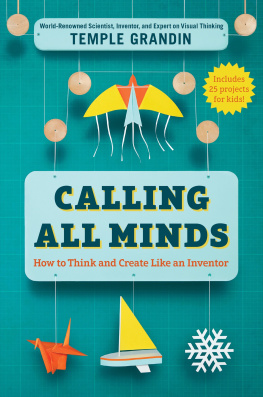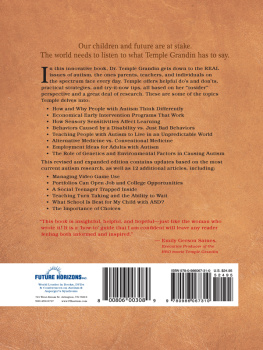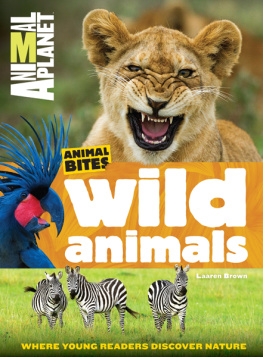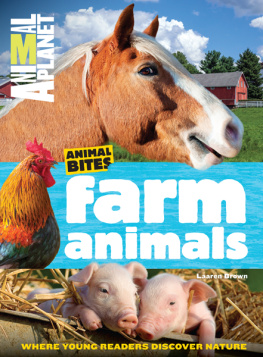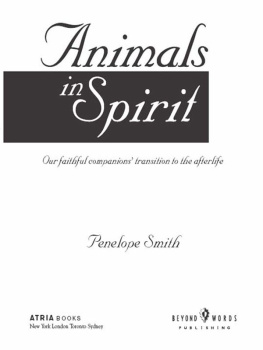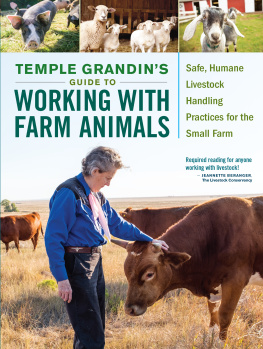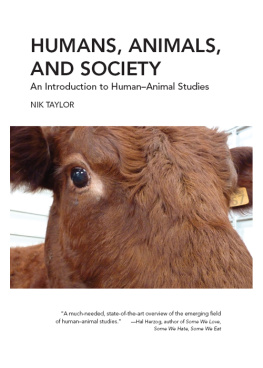Shadow Syndromes: The Mild Forms of Major Mental Disorders That Sabotage Us (with John J. Ratey)
Grandin, Temple.
Animals in translation: using the mysteries of autism to decode animal behavior /
Temple Grandin and Catherine Johnson.
p. cm.
Includes bibliographical references (p. ).
1. Animal behavior. 2. Autism. I. Johnson, Catherine, 1952II. Title.
QL751.G73 2005
591.5dc22
2004058498
1. My Story
P eople who arent autistic always ask me about the moment I realized I could understand the way animals think. They think I must have had an epiphany.
But it wasnt like that. It took me a long time to figure out that I see things about animals other people dont. And it wasnt until I was in my forties that I finally realized I had one big advantage over the feedlot owners who were hiring me to manage their animals: being autistic. Autism made school and social life hard, but it made animals easy.
I had no idea I had a special connection to animals when I was little. I liked animals, but I had enough problems just trying to figure out things like why a really small dog isnt a cat. That was a big crisis in my life. All the dogs I knew were pretty big, and I used to sort them by size. Then the neighbors bought a dachshund, and I was totally confused. I kept saying, How can it be a dog? I studied and studied that dachshund, trying to figure it out. Finally I realized that the dachshund had the same kind of nose my golden retriever did, and I got it. Dogs have dog noses.
That was pretty much the extent of my expertise when I was five.
I started to fall in love with animals in high school when my mother sent me to a special boarding school for gifted children with emotional problems. Back then they called everything emotional problems. Mother had to find a place for me because I got kicked out of high school for fighting. I got in fights because kids teased me. Theyd call me names, like Retard, or Tape recorder.
They called me Tape Recorder because Id stored up a lot of phrases in my memory and I used them over and over again in every conversation. Plus there were only a few conversations I liked to have, so that amplified the effect. I especially liked to talk about the rotor ride at the carnival. I would go up to somebody and say, I went to Nantasket Park and I went on the rotor and I really liked the way it pushed me up against the wall. Then I would say stuff like, How did you like it? and theyd say how they liked it, and then Id tell the story all over again, start to finish. It was like a loop inside my head, it just ran over and over again. So the kids called me Tape Recorder.
Teasing hurts. The kids would tease me, so Id get mad and smack em. That simple. They always started it, they liked to see me react.
My new school solved that problem. The school had a stable and horses for the kids to ride, and the teachers took away horseback riding privileges if I smacked somebody. After I lost privileges enough times I learned just to cry when somebody did something bad to me. Id cry, and that would take away the aggression. I still cry when people are mean to me.
Nothing ever happened to the kids who were teasing.
The funny thing about the school was, the horses had emotional problems, too. They had emotional problems because in order to save money the headmaster was buying cheap horses. Theyd been marked down because they had gigantic behavior problems. They were pretty, their legs were fine, but emotionally they were a mess. The school had nine horses altogether, and two of them couldnt be ridden at all. Half the horses in that barn had serious psychological problems. But I didnt understand that as a fourteen-year-old.
So there we all were up at boarding school, a bunch of emotionally disturbed teenagers living with a bunch of emotionally disturbed animals. There was one horse, Lady, who was a good horse when you rode her in the ring, but on the trail she would go berserk. She would rear, and constantly jump around and prance; you had to hold her back with the bridle or shed bolt to the barn.
Then there was Beauty. You could ride Beauty, but he had very nasty habits like kicking and biting while you were in the saddle. He would swing his foot up and kick you in the leg or foot, or turn his head around and bite your knee. You had to watch out. Whenever you tried to mount Beauty he kicked and bityou had both ends coming at you at the same time.
But that was nothing compared to Goldie, who reared and plunged whenever anyone tried to sit on her back. There was no way to ride that horse; it was all you could do just to stay in the saddle. If you did ride her, Goldie would work herself up into an absolute sweat. In five minutes shed be drenched, dripping wet. It was flop sweat. Pure fear. She was terrified of being ridden.
Goldie was a beautiful horse, though; light brown with a golden mane and tail. She was built like an Arab horse, slender and fine, and had perfect ground manners. You could walk her on a lead, you could groom her, you could do anything you liked and she was perfectly behaved just so long as you didnt try to ride her. That sounds like an obvious problem for any nervous horse to have, but it can go the other way, too. Ive known horses where people say, Yeah you can ride them, but thats all you can do with them. That kind of horse is fine with people in the saddle, and nasty to people on the ground.
All the horses at the school had been abused. The lady they bought Goldie from had used a nasty, sharp bit and jerked on it as hard as she could, so Goldies tongue was all twisted and deformed. Beauty had been kept locked in a dairy stanchion all day long. I dont know why. These were badly abused animals; they were very, very messed up.
But I had no understanding of this as a girl. I was never mean to the horses at the school (other kids were sometimes), but I wasnt any horse-whispering autistic savant, either. I just loved the horses.
I was so wrapped up in them that I spent every spare moment working the barns. I was dedicated to keeping the barn clean, making sure the horses were groomed. One of the high points of my high school career was the day my mom bought me a really nice English bridle and saddle. That was a huge event in my life, because it was mine, but also because the saddles at school were so crummy. We rode on old McClellands, which were honest-to-god cavalry saddles first used in the Civil War. The schools saddles probably went back to World War II when they still had some horse units in the army. The McClelland was designed with a slot down the center of it to spare the horses back. The slot was good for the horse but horrible for the rider. I dont think theres ever been a more uncomfortable saddle on earth, though I have to say that when I read about the Northern Alliance soldiers in Afghanistan riding on saddles made out of wood, that sounded worse.

